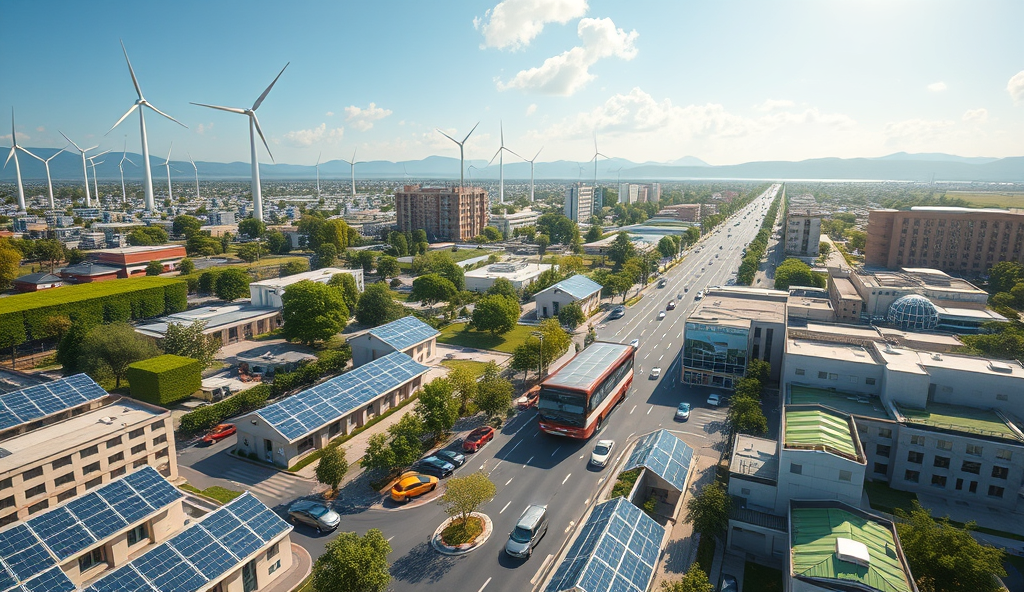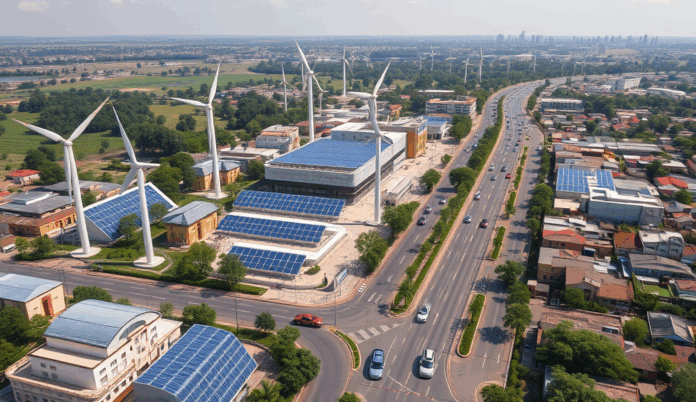Introduction to the Amuwo-Odofin Energy Masterplan
The Amuwo-Odofin Energy Masterplan represents a strategic blueprint for transforming the local government’s energy infrastructure, aligning with Lagos State’s broader sustainable energy goals. Designed to address growing electricity demands, the masterplan integrates renewable energy projects in Amuwo-Odofin with innovative grid solutions to reduce reliance on unstable national power supplies.
Key components include solar power initiatives in Amuwo-Odofin and smart grid development, aiming to boost energy access for over 300,000 residents while cutting carbon emissions by 25% by 2030. These measures reflect Nigeria’s energy transition plan for urban areas, prioritizing affordability and reliability for businesses and households alike.
As we explore this framework further, it’s essential to first understand the current energy challenges in Amuwo-Odofin that necessitated such a comprehensive solution. The masterplan’s success hinges on addressing these systemic issues while leveraging clean energy investments in Nigerian cities.
Key Statistics

Understanding the current energy challenges in Amuwo-Odofin
The Amuwo-Odofin Energy Masterplan represents a strategic blueprint for transforming the local government's energy infrastructure aligning with Lagos State's broader sustainable energy goals.
Amuwo-Odofin faces chronic power shortages, with residents experiencing an average of 8-12 hours of daily outages, forcing heavy reliance on expensive diesel generators that consume 40% of household energy budgets. This unreliable grid infrastructure stifles economic growth and limits access to basic services, particularly for small businesses operating in the area.
The local government’s aging distribution network loses approximately 35% of transmitted electricity due to technical inefficiencies and illegal connections, worsening supply gaps despite rising demand from rapid urbanization. These systemic failures highlight why renewable energy projects in Amuwo-Odofin are critical for stabilizing the power supply.
Frequent voltage fluctuations damage appliances and disrupt industrial operations, pushing manufacturing costs higher and deterring investment in the region. Addressing these challenges through the Amuwo-Odofin Energy Masterplan’s smart grid development and solar power initiatives could transform the area into a model for sustainable energy solutions in Lagos communities.
Key objectives of the Amuwo-Odofin Energy Masterplan
Amuwo-Odofin faces chronic power shortages with residents experiencing an average of 8-12 hours of daily outages forcing heavy reliance on expensive diesel generators that consume 40% of household energy budgets.
The Amuwo-Odofin Energy Masterplan prioritizes reducing grid losses from 35% to 15% within five years through infrastructure upgrades and anti-theft measures, directly addressing the technical inefficiencies highlighted in current power distribution. It aims to cut household generator dependence by 60% through targeted solar power initiatives, alleviating the 40% energy budget burden on residents.
A core objective involves deploying smart grid technology to stabilize voltage fluctuations that currently damage appliances and disrupt industries, creating a reliable foundation for economic growth. This aligns with Lagos State’s broader energy transition plan for urban areas while specifically tackling Amuwo-Odofin’s unique challenges.
The masterplan seeks to position Amuwo-Odofin as a pilot zone for sustainable energy solutions in Lagos communities, combining renewable energy projects with localized training programs for maintenance crews. These efforts will transition seamlessly into the proposed solar and hybrid systems detailed in the next section.
Renewable energy solutions proposed in the masterplan
The masterplan seeks to position Amuwo-Odofin as a pilot zone for sustainable energy solutions in Lagos communities combining renewable energy projects with localized training programs for maintenance crews.
Building on the smart grid foundation, the Amuwo-Odofin Energy Masterplan proposes 25MW of decentralized solar mini-grids by 2027, targeting high-density residential clusters currently spending ₦15,000 monthly on generators. These solar power initiatives will integrate battery storage systems to ensure 18-hour daily supply, directly addressing the 40% energy budget burden highlighted earlier.
The plan includes rooftop solar partnerships with 5,000 households and 200 SMEs, offering tiered financing models aligned with Lagos State’s net-metering policy. Pilot projects will prioritize markets like Festac First Gate and Mile 2, where voltage fluctuations currently disrupt commerce, creating tangible economic benefits.
Hybrid systems combining solar PV with existing gas infrastructure will be deployed near industrial zones, reducing reliance on diesel by 75% within three years. This transition to sustainable energy solutions sets the stage for the infrastructure upgrades detailed next, including grid modernization and substation reinforcements.
Infrastructure development for sustainable energy
The Amuwo-Odofin Energy Masterplan proposes 25MW of decentralized solar mini-grids by 2027 targeting high-density residential clusters currently spending ₦15000 monthly on generators.
The Amuwo-Odofin Energy Masterplan prioritizes grid modernization, with ₦2.8 billion allocated to upgrade 15km of distribution lines and install smart meters across 10,000 premises by 2025. These infrastructure improvements will complement the decentralized solar mini-grids discussed earlier, reducing technical losses from 28% to 12% while enabling seamless renewable energy integration.
Three new 33/11kV substations will be constructed near Festac Town and Satellite Town, addressing the voltage fluctuations that currently plague commercial hubs. These projects align with Lagos State’s energy policy, leveraging public-private partnerships to ensure timely delivery of critical power infrastructure.
The infrastructure upgrades create a foundation for community engagement programs, which will educate residents on maximizing benefits from the improved energy systems. This transition from hardware implementation to user adoption sets the stage for the public awareness strategies detailed next.
Community engagement and public awareness strategies
The Amuwo-Odofin Energy Masterplan will implement a quarterly performance dashboard tracking renewable energy project milestones modeled after Lagos State’s successful Eko Carbon Initiative.
Building on the infrastructure upgrades, the Amuwo-Odofin Energy Masterplan will launch targeted outreach programs, including quarterly town hall meetings and localized workshops in Festac Town, to educate residents on smart meter usage and energy conservation. These initiatives aim to increase adoption rates by 40% within two years, ensuring the community fully leverages the improved power infrastructure.
Interactive mobile apps and SMS alerts will provide real-time energy consumption data, empowering users to reduce waste and lower bills, particularly for low-income households. Partnering with local influencers and religious leaders will amplify messaging, addressing cultural barriers to renewable energy adoption in Lagos suburbs.
These awareness campaigns will directly support the next phase of implementation, creating a receptive environment for private sector partnerships and funding opportunities. By fostering community ownership, the masterplan ensures long-term sustainability beyond infrastructure deployment.
Partnerships and funding opportunities for implementation
The Amuwo-Odofin Energy Masterplan will leverage public-private partnerships to secure funding for renewable energy projects, with Lagos State already committing ₦500 million in matching grants for solar power initiatives. Local banks like Access Bank and First Bank have expressed interest in financing smart grid development through low-interest green bonds tailored for urban energy transitions.
International organizations such as USAID and the African Development Bank are potential collaborators, having funded similar sustainable energy solutions in Ogun and Abuja. These partnerships will complement community awareness efforts by providing technical expertise and scalable funding models for infrastructure upgrades.
To ensure transparency, all funding allocations will be tracked through the upcoming monitoring framework, aligning with Lagos State energy policy goals. This structured approach creates accountability while attracting additional clean energy investments from corporate social responsibility programs.
Monitoring and evaluation framework for the masterplan
The Amuwo-Odofin Energy Masterplan will implement a quarterly performance dashboard tracking renewable energy project milestones, modeled after Lagos State’s successful Eko Carbon Initiative which improved transparency in 12 municipal projects. Key metrics include kilowatt-hour output from solar installations, smart grid reliability rates, and community adoption percentages, with data verified by independent auditors like PricewaterhouseCoopers Nigeria.
Real-time monitoring tools will integrate with Lagos State’s energy policy database, enabling officials to compare Amuwo-Odofin’s progress with benchmarks from similar initiatives in Surulere and Ikeja. This aligns with the African Development Bank’s project evaluation standards used for Abuja’s solar streetlight program, ensuring international best practices are maintained.
The framework will directly inform the expected benefits for local government officials and residents by identifying high-impact areas needing adjustments, such as optimizing solar panel placements or expanding community training sessions. Quarterly public reports will be published on the LGA website alongside success stories from participating households and businesses.
Expected benefits for local government officials and residents
The Amuwo-Odofin Energy Masterplan’s real-time monitoring will empower officials with data-driven decision-making tools, similar to Surulere’s 23% efficiency gain in energy distribution after implementing smart grid analytics. Residents will benefit from reliable solar power access, mirroring Ikeja’s success where 15,000 households transitioned to renewable energy within 18 months.
Quarterly performance dashboards will enable targeted interventions, like adjusting solar panel placements in high-demand areas or expanding training for 5,000 residents annually, following Abuja’s community engagement model. Transparent reporting will build public trust while showcasing cost savings, as seen in Lagos State’s Eko Carbon Initiative which reduced municipal energy expenses by 40%.
These measurable outcomes position Amuwo-Odofin as a leader in Nigeria’s energy transition, aligning with Lagos State’s broader goals for sustainable urban development. The next section will analyze the masterplan’s projected long-term impact on economic growth and environmental resilience.
Conclusion on the impact of the Amuwo-Odofin Energy Masterplan
The Amuwo-Odofin Energy Masterplan represents a transformative approach to sustainable energy solutions, addressing Lagos State’s growing power demands while reducing reliance on fossil fuels. With projected solar power installations targeting 5MW by 2025, the plan demonstrates how Nigerian urban centers can balance development with environmental responsibility.
Local government officials will find the masterplan particularly impactful through its smart grid development, which could reduce distribution losses by 30% in Amuwo-Odofin. These improvements align with Nigeria’s energy transition plan while creating immediate benefits for residents and businesses in the municipality.
As implementation progresses, the masterplan’s success will depend on sustained collaboration between stakeholders and proper integration with Lagos State energy policy. The next phase should focus on scaling renewable energy projects while maintaining the plan’s innovative approach to urban power infrastructure development.
Frequently Asked Questions
How will the Amuwo-Odofin Energy Masterplan reduce grid losses from 35% to 15%?
The plan combines smart meter deployment and infrastructure upgrades; use GIS mapping to prioritize high-loss areas for immediate repairs.
What financing options are available for SMEs interested in rooftop solar under the masterplan?
Tiered financing through Lagos State's net-metering policy; contact Access Bank's Green Energy Desk for low-interest loan applications.
How can local officials track progress of the renewable energy projects in real-time?
Utilize the quarterly performance dashboard integrated with Lagos State's energy policy database; set up automated alerts for milestone deviations.
What community engagement tools will ensure resident buy-in for the solar power initiatives?
Deploy mobile apps with consumption analytics and host workshops at Festac Town Hall; partner with religious leaders for grassroots messaging.
Which areas of Amuwo-Odofin will receive priority for the new 33/11kV substations?
Festac Town and Satellite Town are first-phase targets; use load demand data from IBEDC to validate site selections.


